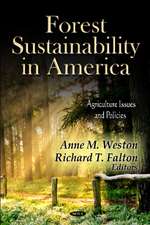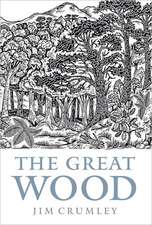Stem Surface Area in Modeling of Forest Stands: SpringerBriefs in Plant Science
Autor Vladimir L. Gavrikoven Limba Engleză Paperback – 6 apr 2017
This book reveals the benefits of describing and modeling trees as the combined surface areas of their stems, and provides a concise overview of the fundamental grounds for adopting such an approach. Anatomically speaking, trees are largely thin sheaths of living cells and it is this understanding that has sparked growing interest in the study of stem surface areas in trees and stands. An overview of publications on analytical methods for the dynamics and structure of forest stands based on stem surface area is also provided.
The approach described here gives readers a chance to rethink some models that were popular for decades, while also offering a glance into future research. The application of a simple geometrical model of a forest stand has made it possible to reexamine a highly promising model, the self-thinning rule, which has been a subject of a protracted discussion for the past few decades. Further, the analysis presented here can serve as the basis for predicting forest stand increments, a topic that calls for further development.
Din seria SpringerBriefs in Plant Science
-
 Preț: 345.63 lei
Preț: 345.63 lei -
 Preț: 379.09 lei
Preț: 379.09 lei -
 Preț: 379.09 lei
Preț: 379.09 lei -
 Preț: 375.23 lei
Preț: 375.23 lei -
 Preț: 377.18 lei
Preț: 377.18 lei -
 Preț: 376.80 lei
Preț: 376.80 lei -
 Preț: 378.71 lei
Preț: 378.71 lei -
 Preț: 379.09 lei
Preț: 379.09 lei -
 Preț: 376.59 lei
Preț: 376.59 lei -
 Preț: 374.30 lei
Preț: 374.30 lei -
 Preț: 377.73 lei
Preț: 377.73 lei -
 Preț: 381.59 lei
Preț: 381.59 lei -
 Preț: 375.07 lei
Preț: 375.07 lei -
 Preț: 349.10 lei
Preț: 349.10 lei -
 Preț: 379.86 lei
Preț: 379.86 lei -
 Preț: 479.67 lei
Preț: 479.67 lei -
 Preț: 441.47 lei
Preț: 441.47 lei -
 Preț: 375.45 lei
Preț: 375.45 lei -
 Preț: 376.59 lei
Preț: 376.59 lei -
 Preț: 377.73 lei
Preț: 377.73 lei -
 Preț: 378.71 lei
Preț: 378.71 lei -
 Preț: 376.22 lei
Preț: 376.22 lei - 15%
 Preț: 460.75 lei
Preț: 460.75 lei -
 Preț: 376.80 lei
Preț: 376.80 lei -
 Preț: 376.22 lei
Preț: 376.22 lei
Preț: 410.77 lei
Nou
Puncte Express: 616
Preț estimativ în valută:
78.60€ • 84.05$ • 65.54£
78.60€ • 84.05$ • 65.54£
Carte tipărită la comandă
Livrare economică 18 aprilie-02 mai
Preluare comenzi: 021 569.72.76
Specificații
ISBN-13: 9783319524481
ISBN-10: 3319524488
Pagini: 103
Ilustrații: X, 100 p. 23 illus.
Dimensiuni: 155 x 235 x 6 mm
Greutate: 0.17 kg
Ediția:1st ed. 2017
Editura: Springer International Publishing
Colecția Springer
Seria SpringerBriefs in Plant Science
Locul publicării:Cham, Switzerland
ISBN-10: 3319524488
Pagini: 103
Ilustrații: X, 100 p. 23 illus.
Dimensiuni: 155 x 235 x 6 mm
Greutate: 0.17 kg
Ediția:1st ed. 2017
Editura: Springer International Publishing
Colecția Springer
Seria SpringerBriefs in Plant Science
Locul publicării:Cham, Switzerland
Cuprins
1. Stem Surface Area as Subject of Study.- 2.Stem Surface Area: Measurement and Development.- 3. Self-thinning and Stem Surface Area.- 4. Stem Respiratory Rate and Stem Surface Area.
Notă biografică
Dr. Vladimir L. Gavrikov is a senior researcher and a lecturer at Siberian Federal University. He has previously worked as a researcher at Institute for Forest of Siberian Branch of the Russia Academy of Sciences, as a Humboldt Foundation Research Fellow at TU Dresden and as a dean of Biology, Geography and Chemistry Department of Krasnoyarsk Pedagogical University. His research interests are primarily in fields of ecological modeling, carbon cycle in forests, and radionuclide migration in forest ecosystems. He led a few projects in the fields sponsored by Russian foundations. He has published about 90 papers and a book Forest growth: levels of description and modeling.
Textul de pe ultima copertă
This book reveals the benefits of describing and modeling trees as the combined surface areas of their stems, and provides a concise overview of the fundamental grounds for adopting such an approach. Anatomically speaking, trees are largely thin sheaths of living cells and it is this understanding that has sparked growing interest in the study of stem surface areas in trees and stands. An overview of publications on analytical methods for the dynamics and structure of forest stands based on stem surface area is also provided.
The approach described here gives readers a chance to rethink some models that were popular for decades, while also offering a glance into future research. The application of a simple geometrical model of a forest stand has made it possible to reexamine a highly promising model, the self-thinning rule, which has been a subject of a protracted discussion for the past few decades. Further, the analysis presented here can serve as the basis for predicting forest stand increments, a topic that calls for further development.
Caracteristici
Focuses on tree stems as popular objects of study in forest science Addresses relationships between tree sizes and how growth/competition relate to those relationships Discusses the well-known self-thinning rule





